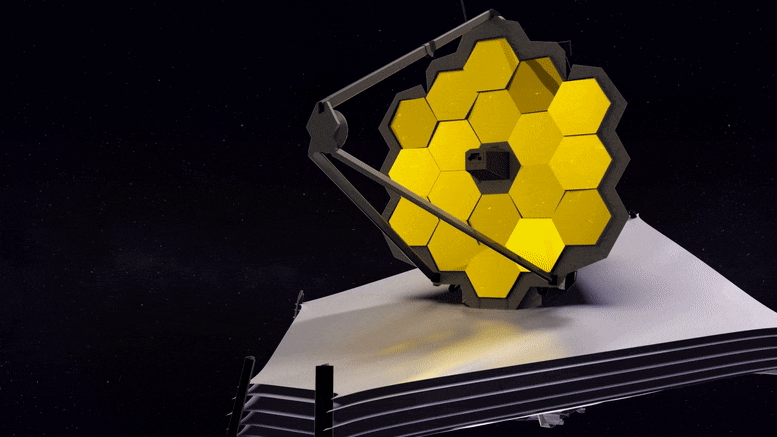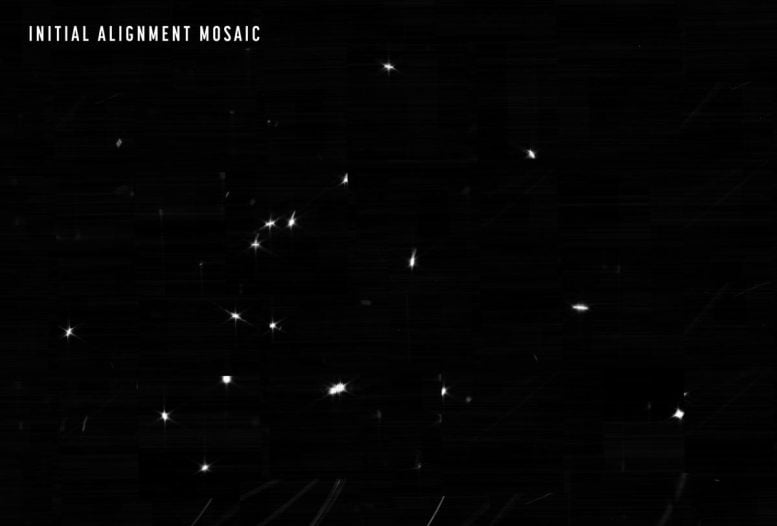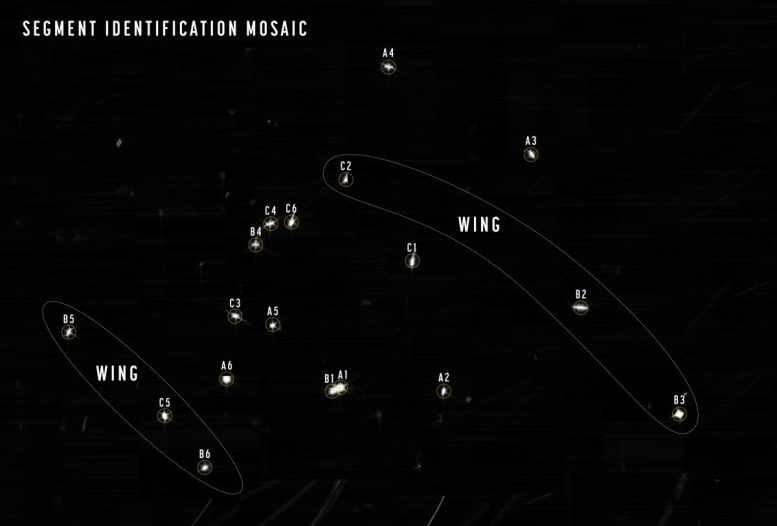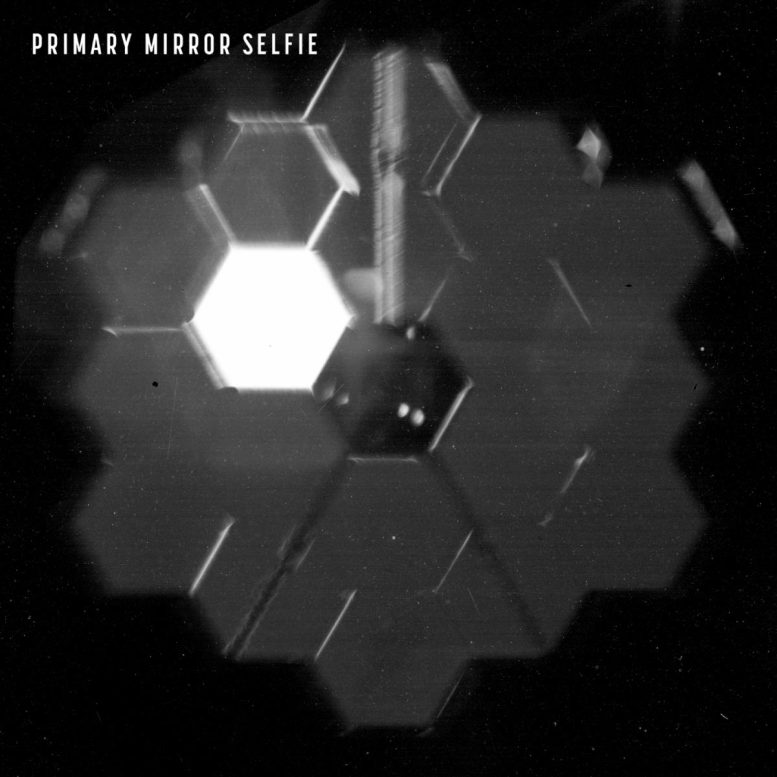
Posted on 02/11/2022 10:49:07 AM PST by Red Badger

James Webb Space Telescope Primary Mirror in Space Credit: NASA’s Goddard Space Flight Center
The James Webb Space Telescope is nearing completion of the first phase of the months-long process of aligning the observatory’s primary mirror using the Near Infrared Camera (NIRCam) instrument.
The team’s challenge was twofold: confirm that NIRCam was ready to collect light from celestial objects, and then identify starlight from the same star in each of the 18 primary mirror segments. The result is an image mosaic of 18 randomly organized dots of starlight, the product of Webb’s unaligned mirror segments all reflecting light from the same star back at Webb’s secondary mirror and into NIRCam’s detectors.

Webb Initial Alignment Mosaic Credit: NASA
What looks like a simple image of blurry starlight now becomes the foundation to align and focus the telescope in order for Webb to deliver unprecedented views of the universe this summer. Over the next month or so, the team will gradually adjust the mirror segments until the 18 images become a single star.
“The entire Webb team is ecstatic at how well the first steps of taking images and aligning the telescope are proceeding. We were so happy to see that light makes its way into NIRCam,” said Marcia Rieke, principal investigator for the NIRCam instrument and regents professor of astronomy, University of Arizona.

Webb Segment Identification Mosaic
This image mosaic was created by pointing the telescope at a bright, isolated star in the constellation Ursa Major known as HD 84406. This star was chosen specifically because it is easily identifiable and not crowded by other stars of similar brightness, which helps to reduce background confusion. Each dot within the mosaic is labeled by the corresponding primary mirror segment that captured it. These initial results closely match expectations and simulations. Credit: NASA
During the image capturing process that began February 2, Webb was repointed to 156 different positions around the predicted location of the star and generated 1,560 images using NIRCam’s 10 detectors, amounting to 54 gigabytes of raw data. The entire process lasted nearly 25 hours, but notedly the observatory was able to locate the target star in each of its mirror segments within the first six hours and 16 exposures. These images were then stitched together to produce a single, large mosaic that captures the signature of each primary mirror segment in one frame. The images shown here are only a center portion of that larger mosaic, a huge image with over 2 billion pixels.
“This initial search covered an area about the size of the full Moon because the segment dots could potentially have been that spread out on the sky,” said Marshall Perrin, deputy telescope scientist for Webb and astronomer at the Space Telescope Science Institute. “Taking so much data right on the first day required all of Webb’s science operations and data processing systems here on Earth working smoothly with the observatory in space right from the start. And we found light from all 18 segments very near the center early in that search! This is a great starting point for mirror alignment.”
VIDEO AT LINK............
Lee Feinberg, Webb optical telescope element manager at NASA’s Goddard Space Flight Center, explains the early stages of the mirror alignment process.
Each unique dot visible in the image mosaic is the same star as imaged by each of Webb’s 18 primary mirror segments, a treasure trove of detail that optics experts and engineers will use to align the entire telescope. This activity determined the post-deployment alignment positions of every mirror segment, which is the critical first step in bringing the entire observatory into a functional alignment for scientific operations.
NIRCam is the observatory’s wavefront sensor and a key imager. It was intentionally selected to be used for Webb’s initial alignment steps because it has a wide field of view and the unique capability to safely operate at higher temperatures than the other instruments. It is also packed with customized components that were designed to specifically aid in the process. NIRCam will be used throughout nearly the entire alignment of the telescope’s mirrors. It is, however, important to note that NIRCam is operating far above its ideal temperature while capturing these initial engineering images, and visual artifacts can be seen in the mosaic. The impact of these artifacts will lessen significantly as Webb draws closer to its ideal cryogenic operating temperatures.
“Launching Webb to space was of course an exciting event, but for scientists and optical engineers, this is a pinnacle moment, when light from a star is successfully making its way through the system down onto a detector,” said Michael McElwain, Webb observatory project scientist, NASA’s Goddard Space Flight Center.

Webb Primary Mirror Selfie This “selfie” was created using a specialized pupil imaging lens inside of the NIRCam instrument that was designed to take images of the primary mirror segments instead of images of space. This configuration is not used during scientific operations and is used strictly for engineering and alignment purposes. In this case, the bright segment was pointed at a bright star, while the others aren’t currently in the same alignment. This image gave an early indication of the primary mirror alignment to the instrument. Credit: NASA
Moving forward, Webb’s images will only become clearer, more detail-laden, and more intricate as its other three instruments arrive at their intended cryogenic operating temperatures and begin capturing data. The first scientific images are expected to be delivered to the world in the summer. Though this is a big moment, confirming that Webb is a functional telescope, there is much ahead to be done in the coming months to prepare the observatory for full scientific operations using all four of its instruments.
It seems to me they could have done a coarse adjustment on Earth.....................
I wanna know if it can ve turned around to ID every russkie tank, PC, ad launcher and mine dispenser on the border of Ukraine? (or any other threat)
If not, it is just a 10 bazillion dollar piece of space trash.
No matter hard you look, you will not see God’s face in such endeavors.
However, my wife tells me that, at 88, it may be time to get my eyes checked...
When you marry someone much younger than you, you often get unnecessary advice
Maybe I need to get vaxxed with the chicom virus enhancer...
There's an animation in the OP article that describes the mirror tuning strategy. It's similar in concept to the strategy a human operator uses in adjusting the focus on a microscope when you sit down to use it. This telescope though is much more though. Eighteen mirrors to align to a single, sharply defined dot. I operated an extremely high end research grade microscope for about 8 years. The tuning of this system is way more than what my setup required. Retired now.
Disclaimer: Opinions posted on Free Republic are those of the individual posters and do not necessarily represent the opinion of Free Republic or its management. All materials posted herein are protected by copyright law and the exemption for fair use of copyrighted works.